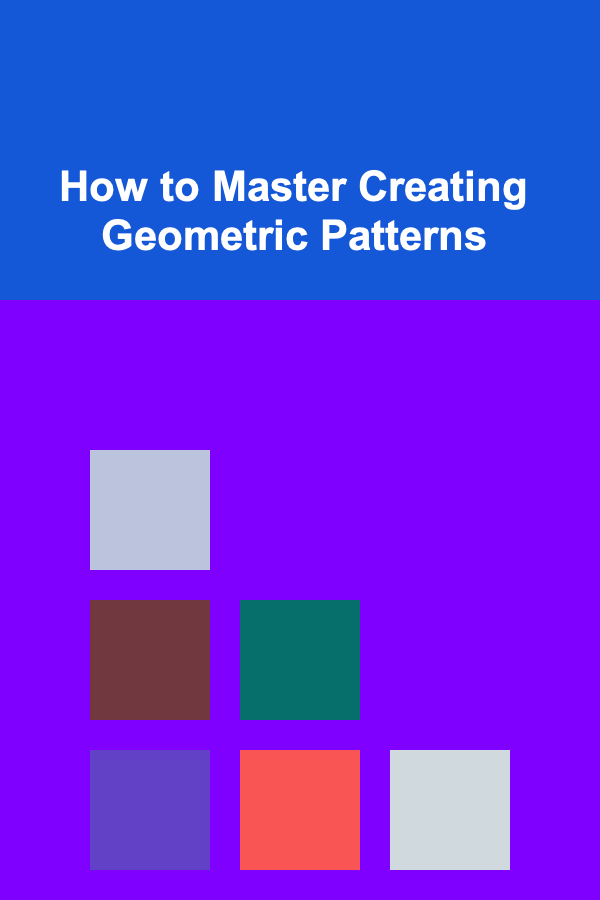
How to Master Creating Geometric Patterns
ebook include PDF & Audio bundle (Micro Guide)
$12.99$6.99
Limited Time Offer! Order within the next:

Creating geometric patterns is an artistic and mathematical process that involves designing visually appealing arrangements of shapes, lines, and forms based on geometric principles. These patterns are widely used in design, art, architecture, textiles, and even modern digital media. They evoke a sense of harmony, balance, and order, offering both aesthetic beauty and intellectual satisfaction. Mastering the creation of geometric patterns requires a deep understanding of geometry, symmetry, color theory, and digital tools, along with a solid foundation in creativity and experimentation. This article explores the journey of mastering the art of geometric patterns, starting from basic principles and moving toward advanced techniques.
Understanding the Basics of Geometry
At the core of geometric pattern creation is geometry---the branch of mathematics concerned with shapes, sizes, and the properties of space. The first step in mastering geometric patterns is to develop a solid understanding of basic geometric concepts, such as:
1. Points, Lines, and Angles
- Point: The most fundamental concept, representing a location in space.
- Line: A straight path that extends infinitely in both directions. Lines can be vertical, horizontal, diagonal, or curved.
- Angle: Formed by two intersecting lines, angles can be acute, right, obtuse, or reflex, and understanding how they interact is critical when building complex patterns.
2. Basic Shapes
- Circles: A circle is defined by its center point and radius, and it is a key element in many geometric designs. Circles can represent harmony and unity.
- Triangles: Triangles are the simplest polygon and can have different properties based on their internal angles (e.g., equilateral, isosceles, and scalene triangles). Triangles are often used to create dynamic, sharp designs.
- Squares and Rectangles: These shapes, formed by right angles, are the building blocks of grids and tessellations, and they bring structure and stability to geometric patterns.
- Polygons: More complex shapes like pentagons, hexagons, and octagons can bring versatility and complexity to a design.
3. Symmetry and Transformation
Symmetry is one of the key features in geometric patterns. Understanding symmetry involves recognizing how shapes and designs can be transformed while maintaining their overall form. Symmetry can be categorized into several types:
- Reflective Symmetry (Mirror Symmetry): This type of symmetry occurs when one side of a shape is the mirror image of the other.
- Rotational Symmetry: Shapes with rotational symmetry can be rotated around a center point and still look the same.
- Translational Symmetry: This occurs when a pattern can be shifted in a particular direction without altering its appearance.
4. Geometric Grid Systems
Grids serve as the foundation for geometric patterns. A grid is essentially a structure of horizontal and vertical lines that define the layout of a design. The grid helps with spacing and alignment, making the design process smoother and more organized. Common types of grids include:
- Square Grids: Consist of evenly spaced vertical and horizontal lines forming squares.
- Hexagonal Grids: A grid of hexagons that allows for more complex and dynamic arrangements.
- Radial Grids: Arrange elements in concentric circles or radii, providing a sense of flow and movement.
The Role of Symmetry in Geometric Patterns
Symmetry is a powerful tool in geometric design. It creates visual harmony and balance, which are essential for creating patterns that are both aesthetically pleasing and structurally sound. Understanding symmetry allows the designer to replicate certain elements across the design, creating a sense of cohesion.
1. Reflection Symmetry (Mirror Symmetry)
Reflection symmetry is used extensively in geometric patterns. It occurs when one part of the design is reflected over a line of symmetry, creating two identical halves. This type of symmetry is common in floral and paisley designs, where a mirrored reflection of the elements enhances the overall appeal.
2. Rotational Symmetry
In rotational symmetry, a pattern is repeated by rotating a shape or motif around a fixed central point. Rotational symmetry is highly effective in creating mandala-like designs, where the same set of elements is rotated multiple times around a central axis. This form of symmetry gives the pattern a sense of infinity and continuity.
3. Translational Symmetry
Translational symmetry involves shifting or repeating a design element along a specific direction. The pattern is created by repeating a basic unit, like a tile, which is shifted along the plane without rotation or reflection. It's widely used in tile patterns, fabrics, wallpapers, and other textiles.
4. Glide Reflection Symmetry
Glide reflection is a combination of a translation and reflection. It is commonly seen in art deco patterns or certain tessellations, where a shape is reflected and then shifted along a line.
Understanding Tessellations
Tessellations are the arrangement of shapes that cover a surface with no gaps or overlaps. They are an essential aspect of geometric pattern creation, providing both aesthetic appeal and mathematical interest. There are two main types of tessellations:
1. Regular Tessellations
A regular tessellation uses one type of regular polygon (e.g., equilateral triangles, squares, or hexagons) to cover the plane. The most famous example of regular tessellations is the use of hexagons in a beehive structure. This type of tessellation is often used in tiling and flooring designs.
2. Semi-Regular Tessellations
These tessellations use two or more different regular polygons arranged in a repeating pattern. An example would be a tessellation that combines squares and equilateral triangles to form a larger, more intricate design. Semi-regular tessellations offer more variety and complexity than regular tessellations while still maintaining a sense of order.
3. Irregular Tessellations
Irregular tessellations are made up of irregular polygons. These designs are less predictable, allowing for a more organic and fluid approach to pattern creation. Artists often experiment with irregular tessellations for more creative and unique visual effects.
Color Theory and Geometric Patterns
While geometric shapes and symmetry are fundamental in creating patterns, color plays a crucial role in elevating the design. The right color choices can add depth, emphasis, and emotion to the pattern. Understanding the principles of color theory can help you make informed decisions when coloring geometric patterns.
1. The Color Wheel
The color wheel is a visual representation of colors arranged by their chromatic relationship. The basic categories include:
- Primary Colors: Red, yellow, and blue---these colors are the foundation for all other colors.
- Secondary Colors: Green, orange, and purple---created by mixing two primary colors.
- Tertiary Colors: The result of mixing a primary and a secondary color.
2. Complementary Colors
Complementary colors are pairs of colors that are opposite each other on the color wheel. When used together, they create high contrast and can make the pattern visually striking. For example, red and green are complementary colors.
3. Analogous Colors
Analogous colors are colors that are next to each other on the color wheel. These colors harmonize well and work together to create a soothing, cohesive effect in geometric patterns. For example, blue, teal, and green create a tranquil and balanced look.
4. Monochromatic Color Schemes
A monochromatic color scheme uses variations of one color. This approach emphasizes tone, shade, and saturation and is often used in minimalist geometric designs to create a unified and elegant pattern.
5. Color Contrast and Balance
Effective use of color contrast can add dimension and interest to geometric patterns. For example, contrasting light and dark shades can create a sense of depth, while using the same color palette in varying intensities adds variation without overwhelming the viewer.
Digital Tools for Creating Geometric Patterns
In the digital age, numerous software tools are available to create geometric patterns, making it easier to experiment, refine, and manipulate designs. Some of the most popular digital tools for creating geometric patterns include:
1. Adobe Illustrator
Adobe Illustrator is one of the most powerful vector graphic software programs available. It allows designers to create scalable geometric patterns with precision, using tools like the pen tool , pathfinder , and pattern maker to create complex designs.
2. CorelDRAW
CorelDRAW is another vector-based software that offers extensive tools for designing geometric patterns. It is widely used in graphic design and digital art, providing flexible options for shape creation, color management, and symmetry tools.
3. Inkscape
Inkscape is an open-source alternative to Adobe Illustrator, providing vector-based drawing tools for creating geometric patterns. It is particularly appealing for those who prefer free software but still need powerful design capabilities.
4. Geogebra
Geogebra is a dynamic mathematics software that helps with the creation of geometric patterns, especially in educational settings. It allows users to create interactive geometric designs, explore transformations, and study the underlying mathematical principles behind the patterns.
5. Procreate
Procreate, a popular app for digital painting, offers powerful brush tools and layering options, making it suitable for both artistic and geometric designs. It's an excellent tool for designers who wish to combine freehand art with geometric precision.
Experimentation and Creativity in Geometric Patterns
The true mastery of geometric pattern creation comes from practice and experimentation. While understanding the principles of geometry and symmetry is essential, the ability to break the rules and push the boundaries of design is what separates great patterns from good ones.
1. Combining Organic and Geometric Elements
One of the most exciting ways to create unique geometric patterns is by combining organic elements with strict geometric shapes. This fusion can result in intricate and dynamic designs, as seen in the work of artists like M.C. Escher and Frank Lloyd Wright, who blended organic motifs with mathematical rigor.
2. Layering and Repetition
Repetition is a key technique in geometric pattern creation. By layering shapes and motifs, you can build more complex designs. This approach allows for both visual complexity and a sense of rhythm, as patterns seem to flow and evolve with each repetition.
3. Play with Scale and Proportions
Changing the scale of certain elements within a geometric pattern can create a sense of tension or movement. Small details juxtaposed with larger shapes can guide the viewer's eye and create a dynamic flow within the design.
4. Breaking Symmetry
While symmetry is a powerful design tool, occasionally breaking symmetry can create an unexpected and intriguing effect. By altering certain parts of a pattern, you can add a sense of unpredictability while still maintaining a sense of balance within the composition.
Conclusion
Mastering the creation of geometric patterns involves a combination of mathematical understanding, artistic vision, and experimentation. By exploring the fundamentals of geometry, symmetry, color theory, and digital tools, you can create patterns that are not only visually stunning but also intellectually engaging. Whether you're designing for a personal project, a client, or just for creative expression, the journey of mastering geometric patterns is one of continuous learning and innovation.

Chief Financial Officer's Toolkit: Managing Financial Risks and Maximizing Profit
Read More
How to Clean and Disinfect High-Touch Surfaces Properly
Read More
How to Incorporate Technology Organizers in Your Family Room
Read More
How to Make a Small Space Feel Festive for the Holidays
Read More
How to Make Use of Closet Space for Storing Equipment
Read More
Mastering the Game: A Comprehensive Guide to Esports Improvement
Read MoreOther Products

Chief Financial Officer's Toolkit: Managing Financial Risks and Maximizing Profit
Read More
How to Clean and Disinfect High-Touch Surfaces Properly
Read More
How to Incorporate Technology Organizers in Your Family Room
Read More
How to Make a Small Space Feel Festive for the Holidays
Read More
How to Make Use of Closet Space for Storing Equipment
Read More